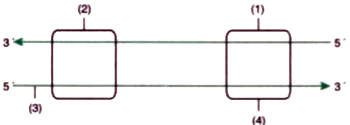DNA strands are termed antilparallel be cause of
H-bonds
phospho-diester bonds
disulphide (S-S bonds)
none of the above
The correct Answer is:B
To understand why DNA strands are termed "anti-parallel," let's break down the concept step by step:
1. Understanding DNA Structure:
- DNA is composed of two strands that form a double helix. Each strand is made up of nucleotides, which consist of a sugar, a phosphate group, and a nitrogenous base.
2. Orientation of DNA Strands:
- Each DNA strand has a directionality, which is defined by the orientation of the sugar molecules in the backbone. One end of the strand has a free phosphate group (5' end), while the other end has a free hydroxyl group (3' end).
3. Definition of Anti-parallel:
- The two strands of DNA run in opposite directions. This means that if one strand runs from the 5' to the 3' direction, the other strand runs from the 3' to the 5' direction. This arrangement is what we refer to as "anti-parallel."
4. Importance of Anti-parallel Orientation:
- The anti-parallel arrangement is crucial for the formation of hydrogen bonds between the nitrogenous bases of the two strands. For example, adenine (A) pairs with thymine (T) and guanine (G) pairs with cytosine (C) through hydrogen bonds.
5. Symmetry and Bonding:
- The anti-parallel orientation allows for proper alignment and symmetry between the base pairs. If the strands were parallel, the bases would not align correctly, leading to improper bonding and instability.
6. Conclusion:
- Therefore, the term "anti-parallel" refers to the opposite directional orientation of the two DNA strands, which is essential for the correct formation of hydrogen bonds between the nitrogenous bases.
Final Answer:
DNA strands are termed anti-parallel because one strand runs in the 5' to 3' direction, while the other runs in the 3' to 5' direction, allowing for proper hydrogen bonding between complementary bases.
- DNA is composed of two strands that form a double helix. Each strand is made up of nucleotides, which consist of a sugar, a phosphate group, and a nitrogenous base.
- Each DNA strand has a directionality, which is defined by the orientation of the sugar molecules in the backbone. One end of the strand has a free phosphate group (5' end), while the other end has a free hydroxyl group (3' end).
- The two strands of DNA run in opposite directions. This means that if one strand runs from the 5' to the 3' direction, the other strand runs from the 3' to the 5' direction. This arrangement is what we refer to as "anti-parallel."
- The anti-parallel arrangement is crucial for the formation of hydrogen bonds between the nitrogenous bases of the two strands. For example, adenine (A) pairs with thymine (T) and guanine (G) pairs with cytosine (C) through hydrogen bonds.
- The anti-parallel orientation allows for proper alignment and symmetry between the base pairs. If the strands were parallel, the bases would not align correctly, leading to improper bonding and instability.
- Therefore, the term "anti-parallel" refers to the opposite directional orientation of the two DNA strands, which is essential for the correct formation of hydrogen bonds between the nitrogenous bases.
DNA strands are termed anti-parallel because one strand runs in the 5' to 3' direction, while the other runs in the 3' to 5' direction, allowing for proper hydrogen bonding between complementary bases.
Topper's Solved these Questions
- ANIMAL TISSUES BOOK - TRUEMEN BIOLOGY ENGLISHCHAPTER - ANIMAL TISSUES EXERCISE - MULTIPLE CHOICE QUESTIONS
193 Videos
- CELL- THE BASIC UNIT OF LIFE ( CELL AND ITS STRUCTURAL ORGANISATION )BOOK - TRUEMEN BIOLOGY ENGLISHCHAPTER - CELL- THE BASIC UNIT OF LIFE ( CELL AND ITS STRUCTURAL ORGANISATION )EXERCISE - MULTIPLE CHOICE ANSWER TYPE
308 Videos
Similar Questions
DNA strands are termed antiparallel because of
View SolutionDNA strands have
View SolutionDNA strands are antiparallel because of the presence of :
View SolutionDNA strands are joined by
View SolutionDNA strand is synthesized in the direction
View SolutionAssertion: UV - rays are carcinogenic in future.
Reason: UV - rays rupturek DNA strands and induce mutations to cause cancers.
View SolutionThe two strands of DNA are not identical, but are complementary'. Explain this statement.
View SolutionIn the following diagram the two DNA strands represented are ready for transcription.
Which one of the two strands of DNA has nucleotide sequence similar to mRNA that will be transcribed and why?

View Solution
AB and CD represent two strands of a DNA molecule. When it undergoes replication, forming a replication fork between A and C:
Using which strand as the template, will there be continuous synthesis of a complementary DNA strand?
View SolutionIf the sequence of bases in one strand of DNA is known then the sequence in other strand can be predicted on the basis of -
View Solution
